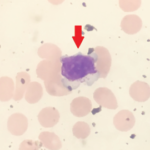Vertebral osteomyelitis is an infection of bone and surrounding tissue. A study recently published in The Lancet has found that patients with pyogenic vertebral osteomyelitis respond as well to six weeks of antibiotic therapy as they do to 12 weeks of antibiotic therapy.1
Specifically, a six-week treatment regimen resulted in a 90.9% cure rate at one year, which was identical to the rate seen with 12 weeks of therapy. The results suggest that treatment duration for these patients can be reduced to six weeks from the standard 12.
To determine the efficacy of treatment regimens, researchers Louis Bernard, MD, PhD, chief of the Division of Infectious Diseases at the University Hospital Bretonneau in Tours, France, and colleagues conducted a large (n = 351), open-label, randomized clinical trial between November 2006 and March 2011. They focused on patients with vertebral osteomyelitis that was non-brucellar and non-mycobacterial and studied a high-risk generalizable population of patients who were being managed with current clinical guideline-supported drugs.
The trial was designed to assess non-inferiority between the two treatment regimens using a 10% margin. Patients for whom treatment duration was longer than the randomized time period were considered to be treatment failures.
While the trial was open-label, members of the independent adjudication committee were blinded to the duration of the antibiotic treatment. Approximately one-half of the patients received intravenous treatment for less than 14 days. Thus, the study relied on oral antibiotics with a high bioavailability, such as fluoroquinolones and rifampicin. In addition to demonstrating non-inferiority of the six-week protocol, the results confirm that patients with pyogenic vertebral osteomyelitis rarely experience microbiological relapse.
Infectious disease specialists Jaime Lora-Tamayo, MD, at the Hospital Universitario 12 de Octubre in Madrid, and Oscar Murillo, MD, PhD, at Hospital Universitario de Bellvitge in Barcelona, commented on the study in an accompanying editorial: “[W]e feel confident that a short treatment regimen is probably sufficient for most patients with vertebral osteomyelitis. However, the sample size needed for this study precluded the investigators from obtaining very homogenous cases from an aetiological and clinical point of view; the virulence and ability to generate biofilm and bone destruction differ between Staphylococcus aureus, several species of Streptococcus, and Enterobacteriaceae. Also, differences in soft tissue involvement, especially between phlegmon and abscesses, might have particular relevance for clinicians,” they wrote.2
In their editorial, the physicians point out that only 19% of patients in the study had abscesses, and only 4% of those patients required computed tomography-guided drainage. In addition, very few of the patients were infected with multidrug-resistant microorganisms. Thus, Drs. Lora-Tamayo and Murillo recommend that physicians be cautious when shortening the duration of antibiotic therapy if the patient is suffering from extensive bone destruction or abscesses, or is infected with virulent, multidrug-resistant microorganisms.

